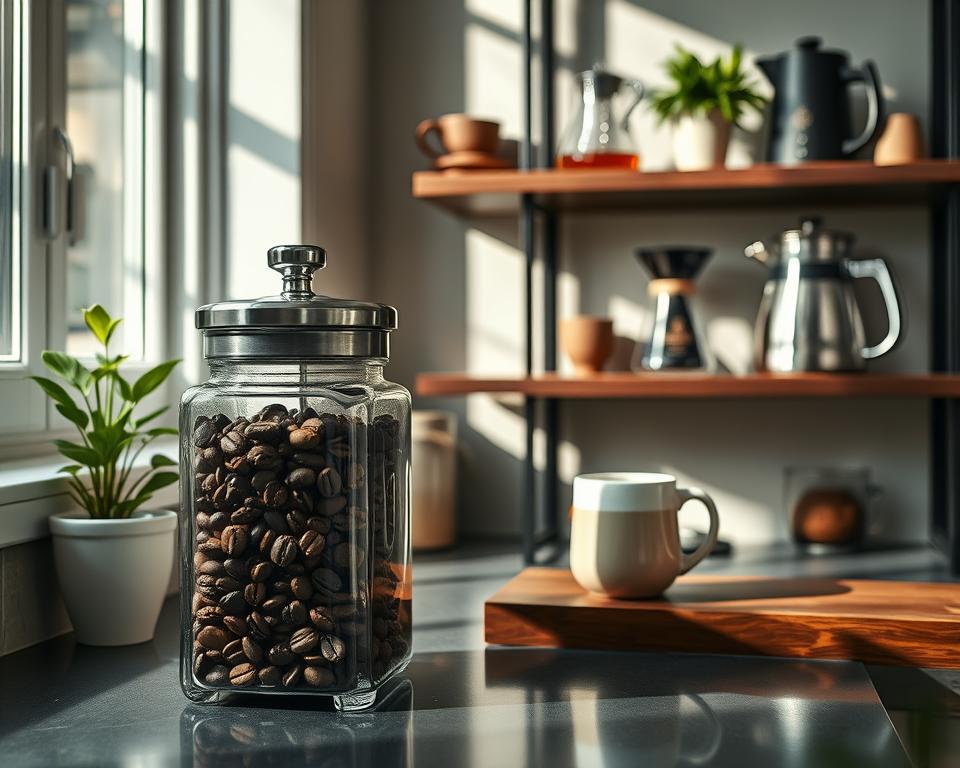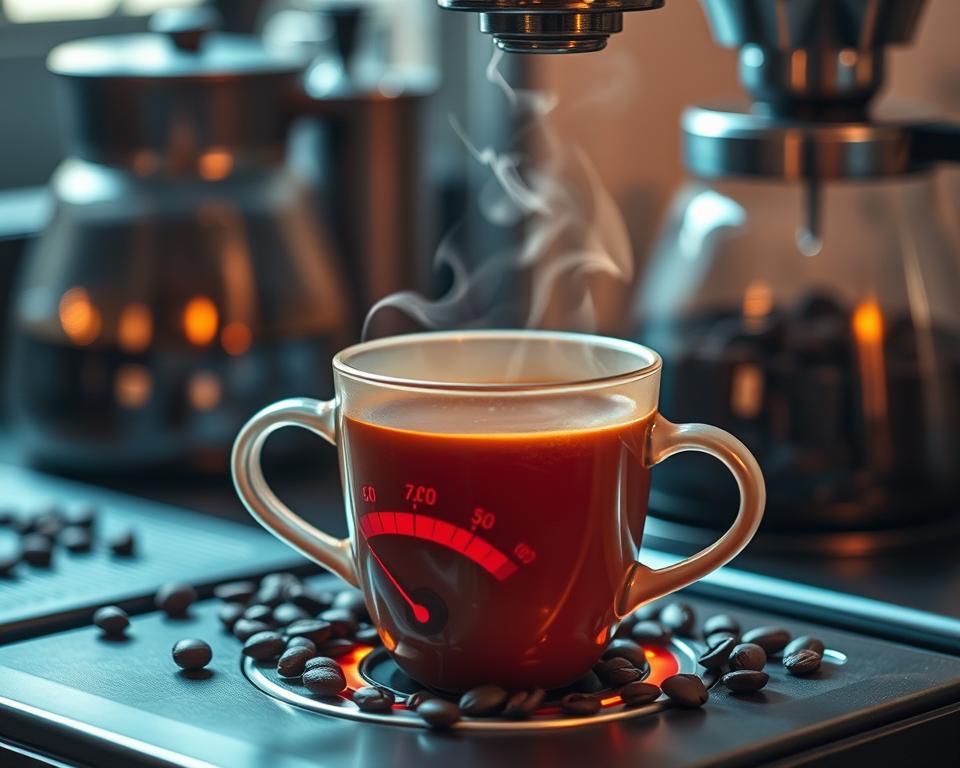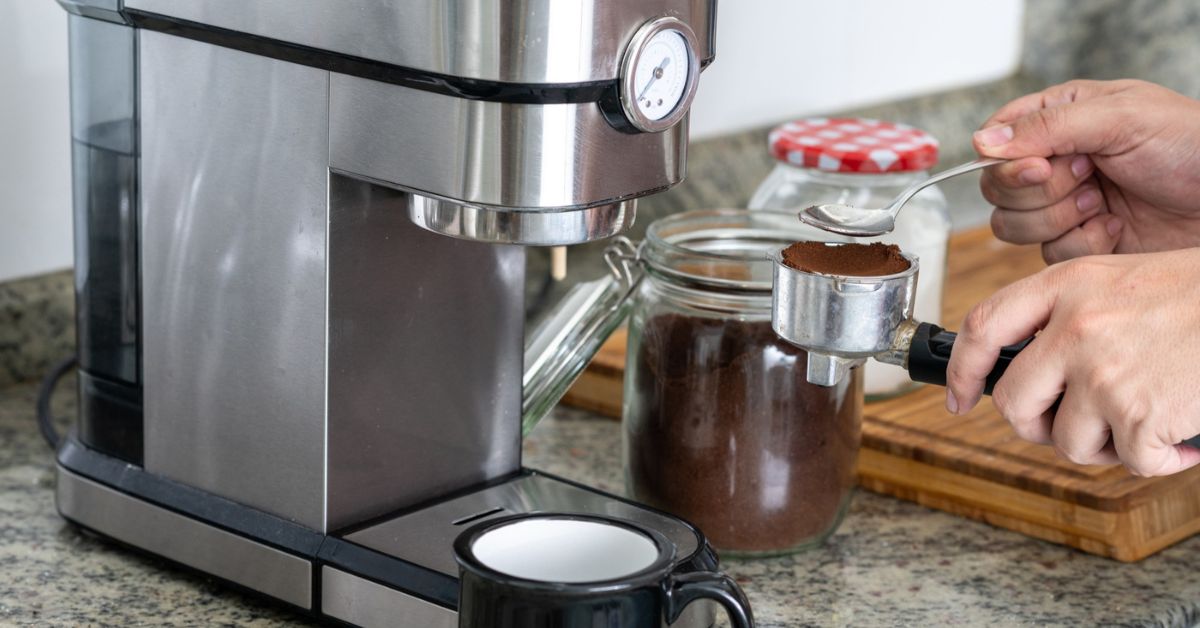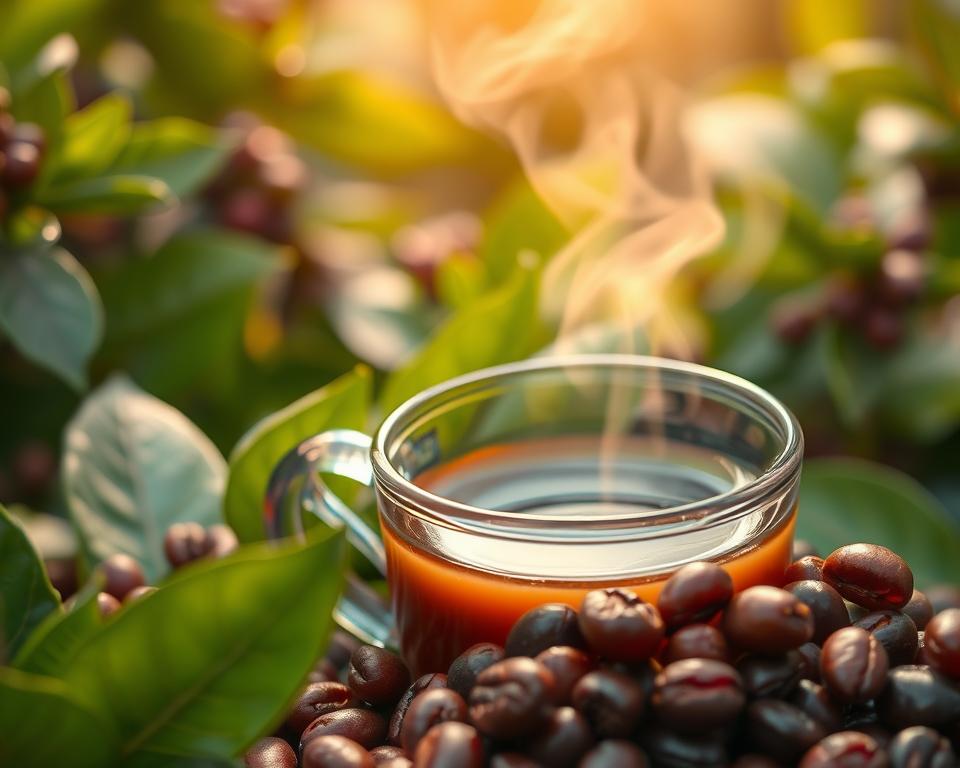Brewing the perfect cup of coffee at home can be delightful but challenging. We often make small mistakes that affect the coffee’s taste. By tweaking our brewing methods, we can greatly improve our coffee.
How we store coffee beans is very important. Keep them away from moisture and extreme temperatures to maintain freshness. Ideally, use coffee beans within three weeks of roasting. A good coffee-to-water ratio is two heaping tablespoons per cup. This ensures a quality and consistent taste.
Using water at the wrong temperature is a common mistake. The ideal range is between 195F and 205F for perfect flavor. This temperature range helps extract the best flavors without bitterness. Use a quality thermometer or a kettle with temperature control to get it right.
Another error is choosing the wrong grind size for your brewing method. For example, a French press needs coarse coffee, while espresso needs a fine grind. A burr grinder can give you the right particle size. This improves brewing consistency and taste.
The quality of water used is often not considered. Bad-tasting water will ruin your coffee. Always use filtered water instead of tap water. This simple change can significantly enhance the flavor of your coffee.
Storing Coffee Incorrectly
Many coffee lovers might not know how sensitive their beans are to dampness, heat, and their surroundings. Wrong storage can spoil the flavor. This makes that great cup of coffee less satisfying. Using airtight containers is key. They keep coffee fresh.

Impact of Humidity and Temperature
Humidity and temperature play big roles in coffee’s quality. Keeping coffee near moisture, like in fridges or freezers, is bad. This can make beans pick up icky smells and tastes. Also, freezing beans can mess up their oils. This ruins their unique flavor. Coffee stays best when stored between 50 and 70 degrees Fahrenheit, in a spot that’s cool and dry.
- Moisture leads to flavor degradation.
- Unwanted odors can be absorbed if stored alongside strongly scented foods.
- Freezing can cause moisture condensation, damaging coffee’s quality.
Avoid putting beans in the fridge or freezer. Instead, store them somewhere cool and dry. This helps keep coffee fresh longer.
Best Storage Practices
For good coffee storage, use airtight and dark containers. They guard against light, keeping beans fresh and tasty. Remember to check the roast date. Beans are most flavorful 2-10 days after roasting. Use them within two to four weeks of that date.
- Utilize opaque, airtight containers for optimal storage.
- Store coffee in a cool, dry place away from light and heat.
- Use beans within two weeks to maintain peak flavor.
I suggest buying the right storage solutions. Also, use beans at their best time to get amazing coffee. Whole bean coffee stays fresh longer than ground coffee. So try grinding right before you brew.
Using Incorrect Water Temperature
Brewing coffee? The water temperature is key to a great cup. You want your water between 195°F and 205°F (91°C to 96°C). This temperature range helps get the best flavor without over-extraction or burning.
Ideal Water Temperature Range
It’s crucial to keep the water at the right temperature. If it’s too hot, your coffee might taste bitter. If it’s too cold, your coffee could end up watery and weak. Using the 195°F to 205°F range is perfect for methods like French press or pour-over.
For a French press, this temperature helps extract all the good oils and flavors. There’s no bitterness. It makes a big difference.
Equipment to Control Water Temperature

Getting the right gear can make a huge difference in coffee temperature control. Many coffee makers now can keep the water just right. For pour-over fans, a kettle with a temperature gauge is key.
Smart espresso machines adjust temperature automatically, making life easier. A good burr grinder also improves your coffee’s taste. These tools help ensure your coffee is always flavorful.
Choosing the Wrong Grind Size
Choosing the right grind size is key to great coffee. This step is crucial for proper extraction and consistency.
Matching Grind Size to Brewing Method
Different brews need different grind sizes for best results. Here’s a quick guide:
- Turkish Coffee: Extra Fine
- Espresso: Fine
- Moka Pot: Fine-Medium
- Aeropress: Medium-Fine
- Pour Over (V60, Chemex): Medium
- Siphon: Medium
- Drip Coffee: Medium
- Cold Brew: Coarse-Medium
- French Press: Coarse
- Percolator: Coarse
The wrong grind size can ruin your coffee, making it sour or bitter. The right grind size brings out the perfect balance and flavor.
Advantages of Burr Grinders
Burr grinders are the best for even grinding. They offer a consistent grind for a balanced taste. Compared to blade grinders, burr grinders crush beans evenly. This helps in extracting coffee uniformly. One top choice is the Baratza Encore, great for a coarse grind in French Press or Cold Brew.
A uniform grind is essential for excellent coffee. It must meet the Golden Cup Standard of 18-22% extraction. If the grind size is incorrect, you won’t get the best flavor balance.
It’s also important to keep your grinder clean. I use uncooked white rice to clean my burr grinder. This trick keeps the burrs clean and ensures the best coffee taste. It’s part of my regular coffee routine.
How Can High-Tech Coffee Brewing Gadgets Help Avoid Common Brewing Mistakes?
Hightech coffee brewing gadgets revolutionize the way coffee enthusiasts prepare their brews. By providing precise temperature control and automatic timing, these devices help avoid common brewing mistakes like over-extraction or under-extraction. With innovative features, they ensure your coffee is consistently delicious, elevating your morning ritual to perfection.
Using Bad-tasting Water
Water quality is key for great coffee. If your water tastes bad, your coffee will too. Remember, nearly 99% of your coffee is water. So, bad flavors or impurities in water can ruin your coffee’s taste.
Importance of Water Quality
The water’s minerals deeply affect your coffee. Poor tap water can make your coffee taste flat. Using filtered or bottled water can fix these problems. It makes your coffee cleaner and tastier. If you like your tap water’s taste, you might be okay.
Filtered vs. Tap Water
Filtered water usually beats tap water for coffee. Tap water can have things in it that mess up the coffee-making process. Filtered water keeps the taste consistent and better. If you love rich coffee, get a good filter.
Also, swapping filters regularly keeps it working right. For coffee tips, see this Cafe Breve recipe. It shows how every part, including water, matters for amazing coffee.
FAQ
What are the common coffee brewing mistakes and how can I fix them?
People often store coffee wrong, use water that’s too hot or cold, or pick the wrong grind size. Keep your coffee dry, use water that’s between 195F and 205F, and choose the right grind for your brew method.
How does humidity and temperature impact coffee storage?
Coffee doesn’t like humidity and temperature changes. Keeping it in the fridge or freezer can make it taste weird. It absorbs unwanted smells and flavors, which ruins its quality.
What are the best storage practices for coffee?
Keep your coffee in a cool, dry spot. Use an airtight container. Mason jars or similar items work great for protecting it from the environment.
What is the ideal water temperature range for brewing coffee?
For the best coffee, use water that’s between 195F and 205F. This prevents over-extraction or burning, which can spoil the taste.
What equipment can help control water temperature for coffee brewing?
Quality tools like a precise grinder, good coffee machines, or smart espresso makers make a big difference. They help keep the temperature just right for a tasty cup of coffee.
Why is matching grind size to the brewing method important?
Each brew method needs a specific grind size for the best coffee. A coarse grind is good for French press, and a fine grind suits espresso. The right grind size makes your coffee taste great.
What are the advantages of using burr grinders for coffee?
Burr grinders make the grind size consistent, which is key for delicious coffee. They avoid the uneven grinds other grinders can cause.
Why is water quality important for coffee brewing?
Since coffee is mostly water, its taste significantly affects your coffee. Only use water that tastes good on its own for brewing.
Should I use filtered or tap water for brewing coffee?
Choose filtered or bottled water over tap to keep your coffee’s taste clean. Make sure your home filters are well-maintained with fresh cartridges.




